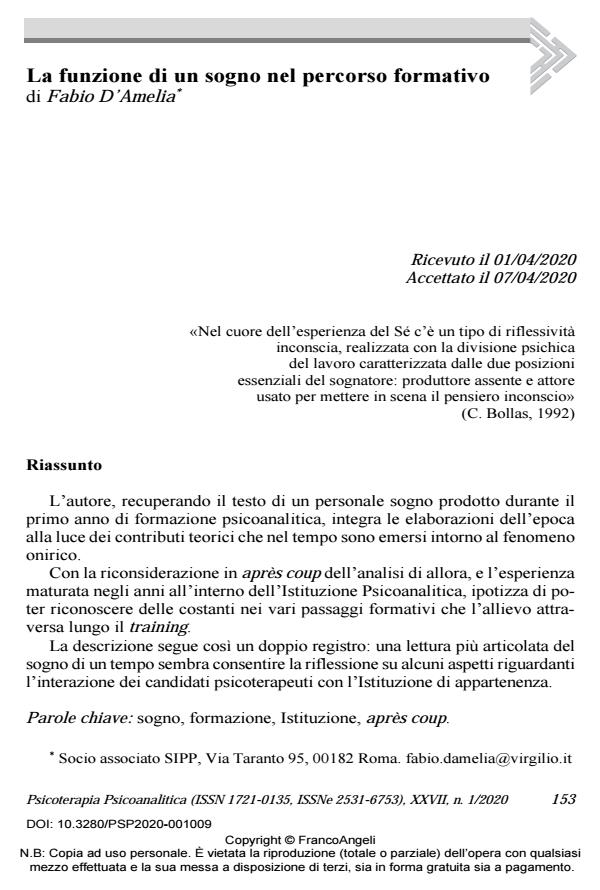The role of a dream during psychoanalytic training
Journal title PSICOTERAPIA PSICOANALITICA
Author/s Fabio D’Amelia
Publishing Year 2020 Issue 2020/1 Language Italian
Pages 12 P. 153-164 File size 207 KB
DOI 10.3280/PSP2020-001009
DOI is like a bar code for intellectual property: to have more infomation
click here
Below, you can see the article first page
If you want to buy this article in PDF format, you can do it, following the instructions to buy download credits

FrancoAngeli is member of Publishers International Linking Association, Inc (PILA), a not-for-profit association which run the CrossRef service enabling links to and from online scholarly content.
Recollecting the contents of a dream he had during his first year of psychoanalytic training, the Author integrates the original elaboration with the theoretical contributions on oneiric phenomena that were pro-duced in the following years. Through his reconsideration in après coup of the past analysis and the experience gained within the psychoanalytic organization, the Au-thor highlights some constants in the several steps a training process is composed of. The description that follows can be read at two different levels: a more complex reading of the old dream seems to allow a reflection on the interaction between psychotherapists-to-be and the organization they belong to.
Keywords: Dream, training, organization, après coup.
- Ambrosiano L. (2010). Il lavoro del maestro. -- http://www.centropsicoanalisiromano.it/archivio-lavori-scientifici/archivio-storico-dal-2001-a-oggi/114-ambrosiano-il-transfert-sul-maestro-2010.html
- Cosenza D. (2003). La posizione e l’intervento dell’analista nella teoria di Lacan. In: Di Ciaccia A. (a cura di). Il desiderio dell’analista. Roma: Borla, 2011.
- Balsamo M., Napolitano F. (1998). Freud, lei e l’altro. Sulla genesi della teoria psicoanalitica. Milano: Franco Angeli.
- Bollas C. (1992). Essere un carattere. Roma: Borla, 2007.
- Bolognini S. (cura di) (2016). Prefazione. Il sogno cento anni dopo. Milano-Udine: Mimesis Edizioni, 2016.
- Freud S. (1914). Introduzione al narcisismo. OSF, 7.
- Freud S. (1916). Coloro che soccombono al successo in alcuni tipi di carattere tratti dal lavoro psicoanalitico. OSF, 8.
- Freud S. (1922). Due voci di enciclopedia: “Psicoanalisi” e “Teoria della libido”. OSF, 9, 1978.
- Giuffrida A. (1994). Modalità di relazione nella, e con, l’Istituzione e aspetti controtransferali dell’analista. Psicoterapia e Istituzioni, 1: 10-20.
- Jung C.G. (1969). Gli archetipi e l’inconscio collettivo. Coscienza, inconscio e individuazione. In: Opere, vol. 9. Boringhieri: Torino, 1980.
- Ogden T.H. (1989). Il limite primigenio dell’esperienza. Roma: Astrolabio, 1992.
- Ogden T.H. (2016). Vite non vissute. Milano: Cortina, 2020.
- Roudinesco E. (2014). Sigmund Freud nel suo tempo e nel nostro. Torino: Giulio Einaudi, 2015.
- Scarfone D. (1998). Prefazione. Freud, lei e l’altro. Sulla genesi della teoria psicoanalitica. Milano: Franco Angeli, 1998.
- Winnicott D.W. (1963). Comunicare e non comunicare: studio su alcuni opposti. In Sviluppo affettivo e ambiente. Armando: Roma, 1963.
Fabio D’Amelia, La funzione di un sogno nel percorso formativo in "PSICOTERAPIA PSICOANALITICA" 1/2020, pp 153-164, DOI: 10.3280/PSP2020-001009